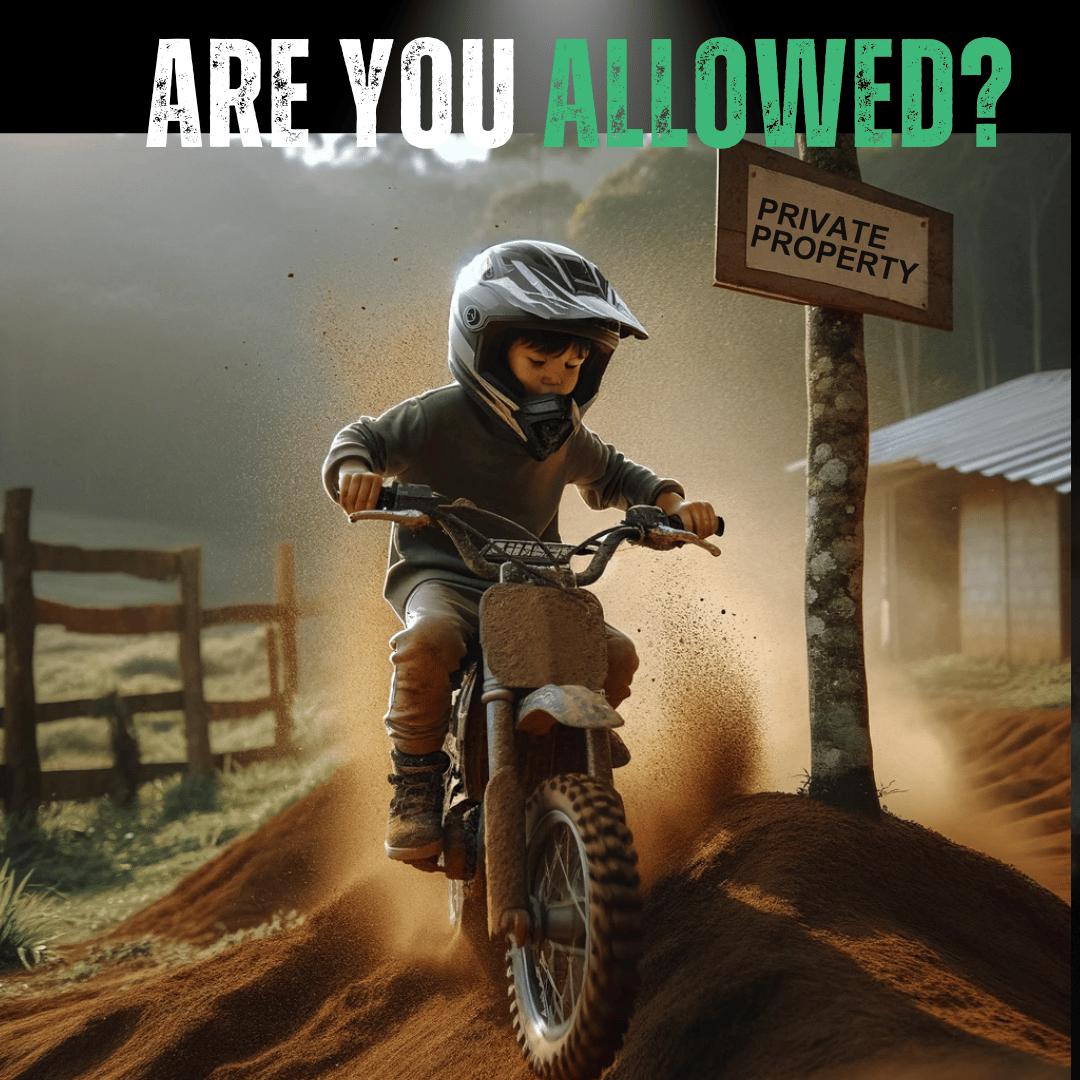
Updated: 14.05.25
Can you ride dirt bikes on private property or in your backyard? This guide explores the legalities, safety, and tips for lawful off-road adventures, perfect for enthusiasts or parents eyeing a kids’ ride-on dirt bike. Discover how to ride responsibly on private land.
1. Legal Requirements for Dirt Biking on Private Property
Riding dirt bikes on private land requires landowner permission and compliance with local regulations to avoid legal issues.
| Consideration | Details |
|---|---|
| Landowner Permission | Secure explicit consent; respect rules to maintain access. |
| Local Regulations | Check bylaws for noise, environmental, or zoning restrictions. |
Related: UK Dirt Bike Laws
2. Obtaining Landowner Permission
Secure permission to ride dirt bikes on private property with clear, respectful communication to build trust.
- Request Details: Outline rider numbers, bike types, and times via letter or in-person.
- Liability Waivers: Provide a signed waiver to acknowledge risks.
- Ongoing Respect: Follow rules to ensure future access.
Related: Are Dirt Bikes Street Legal in the UK?
3. Riding Dirt Bikes in Residential Areas or Backyards
Can you ride dirt bikes in your backyard or residential areas? Yes, with landowner permission and adherence to local noise or nuisance bylaws. Residential riding requires extra care to avoid disturbing neighbours.
- Noise Bylaws: Check local rules to ensure compliance, especially in suburbs.
- Neighbour Consideration: Ride during daytime and use quieter exhausts.
- Small Spaces: Ensure backyards are large enough for safe riding.
Related: Where to Ride Dirt Bikes in the UK
4. Safety on Private Land
Safety is critical, even on private property. Responsible riding protects riders and maintains landowner trust.
| Aspect | Details |
|---|---|
| Safety Gear | Wear helmets, gloves, and protective clothing meeting standards. |
| Property Respect | Stick to trails, avoid wetlands or crops. |
- Gear Checks: Inspect helmets and pads regularly.
- Land Mapping: Identify hazards or restricted areas.
5. Equipment and Bike Requirements
Ensure your dirt bike meets landowner and safety standards to minimise impact and ensure compliance.
- Safety Features: Use spark arrestors and mufflers.
- Eco-Friendly Tyres: Choose trail-safe tyres to protect land.
- Maintenance: Keep brakes and suspension in top condition.
Related: Dirt Bike vs. ATV: Pros and Cons
6. Insurance for Dirt Biking
Comprehensive insurance covers property damage and injuries, reassuring landowners and protecting you.
- Coverage Needs: Include liability and medical insurance.
- Landowner Trust: Shows responsibility for access.
Related: Buying a Cheap Dirt Bike
7. Minimising Noise in Residential Areas
Reduce noise to respect landowners and neighbours, especially in backyards or residential areas.
- Mufflers: Install quiet exhaust systems.
- Daytime Riding: Avoid early mornings or evenings.
- Community Talks: Set expectations with locals.
8. Finding Private Land Near You
To find private land to ride dirt bikes near you, contact local off-road clubs, check community boards, or approach landowners directly. Always secure permission and respect their rules.
- Clubs: Join groups for access to private land networks.
- Landowner Outreach: Ask politely with clear riding plans.
- Local Resources: Use forums or apps for off-road opportunities.
9. Alternative Riding Locations
Explore other venues for diverse dirt biking experiences.
- Off-Road Parks: Offer trails and rider communities.
- Motocross Tracks: Build skills with technical challenges.
- Public Trails: Provide amenities like emergency services.
Conclusion
Riding dirt bikes on private property or backyards is thrilling when done legally and responsibly. Secure permission, follow bylaws, and prioritise safety to enjoy off-road fun while respecting landowners and neighbours. Explore our kids’ ride-on motorbikes for safe adventures!
Frequently Asked Questions
Can you ride dirt bikes on private property without permission?
No, riding without permission risks trespassing charges. Always secure landowner consent.
Can you ride dirt bikes in your backyard?
Yes, with permission and compliance with local noise or nuisance bylaws, ensuring minimal disturbance.
How do I find private land to ride dirt bikes near me?
Join off-road clubs, check local forums, or contact landowners directly, always securing permission.
Are there legal requirements for kids’ ride-on dirt bikes on private land?
Landowner permission is essential. Check local bylaws for noise or safety rules in residential areas.
Can ride-on dirt bikes be used on any terrain?
Check specifications; some suit flat surfaces, others handle rough terrain. Follow guidelines to avoid damage.
How do I maintain a ride-on dirt bike for off-road use?
Check tyre pressure, battery, and fittings regularly. Store in a dry, sheltered place per the manual.
Get in Touch 🚀
Loved our guide on “Can You Ride Dirt Bikes on Private Property?”? Ready for more off-road adventures?
Explore ride-on toys at RiiRoo.com or chat via Live Chat for dirt bike tips!









Share:
7 Common Motorcycle Blind Spot Mistakes
What Is The Minimum Age To Ride An Adult E-Scooter in 2025?